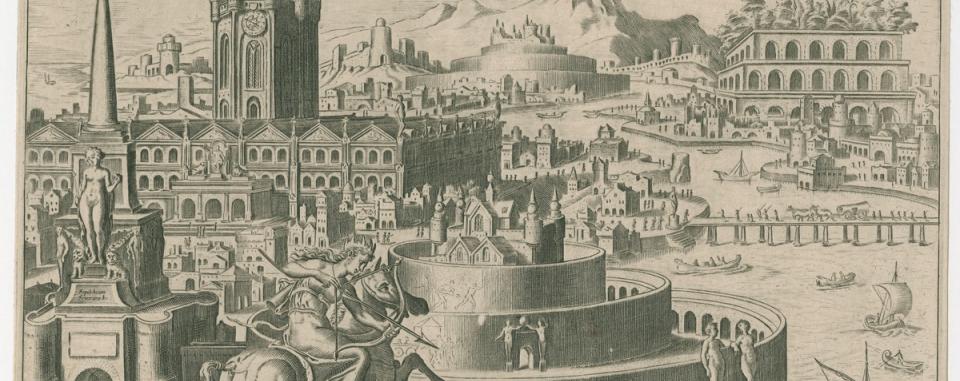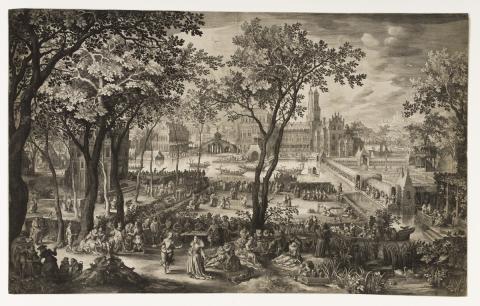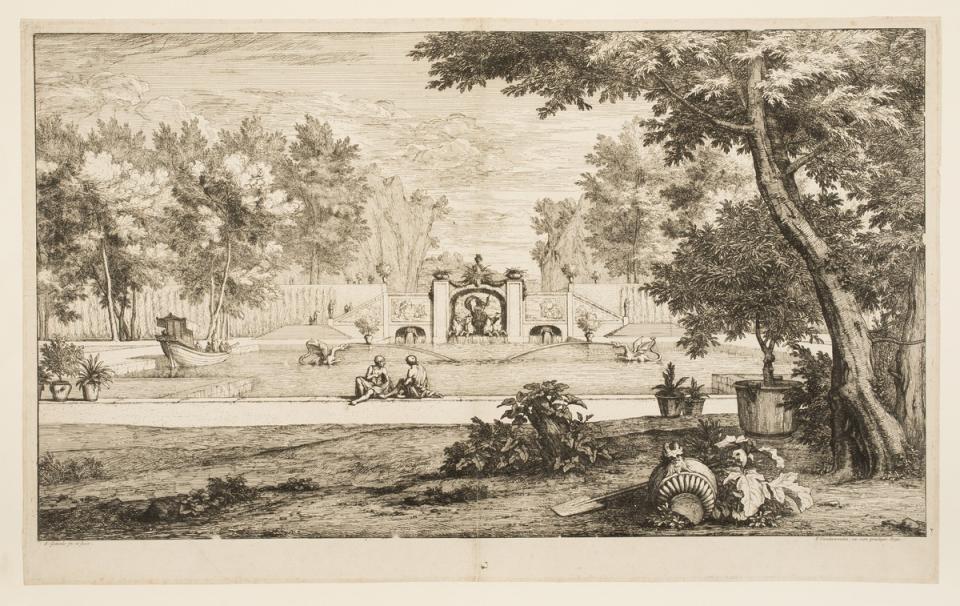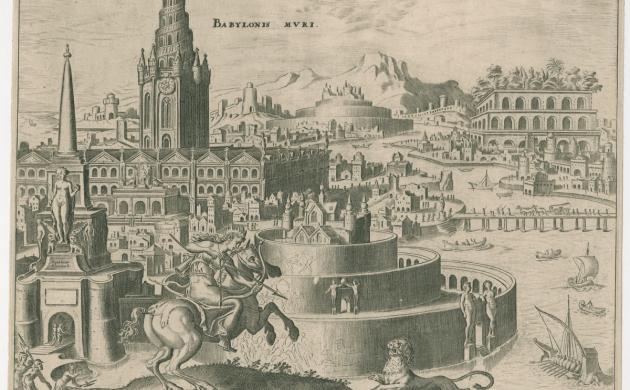The garden. A living piece of nature. The extension of our personality, of our dreams. A mirror of our society: its abilities, its ideas, its developments, its needs.
But needs change over time and so do gardens. Although the quest for happiness continues to be the same. Over time, however, where and how we seek it, the resources and the gardens have changed.
The Museum Plantin-Moretus has a wealth of prints and drawings that beautifully illustrate the evolution of gardens.
In this online exhibition:
Tip: click the images below to see them in high resolution or download them.
Wondrous gardens that fuel the imagination
According to ancient authors, King Nebuchadnezzar ordered the construction of the fabled hanging gardens of Babylon 2500 years ago to lift the spirits of his young, homesick bride. They mention the ingenious irrigation techniques with spirals and waterwheels to pump water from the river to the garden.
These gardens, which were probably built near present-day Baghdad, were a place of supreme happiness for the occupants of this desert land. The Persian word for an enclosed pleasure garden is Pairi-dae-za by the way.
Maarten Van Heemskerck (1498-1574) designer, Philips Galle (1537-1612) engraver. The Hanging Gardens of Babylon. From the ‘Octo Mundi Miracula’ series. Copper engraving. PK.OP.13172
From pairi-dae-za to the garden of eden
It is said that the most beautiful garden, in which humans and animals lived in harmony in pleasant natural surroundings, was planted by God himself: the Garden of Eden, paradise, the symbol of a better world, of a better life. Whereas mankind struggled in difficult conditions, working daily to control nature in order to survive, paradise is a more harmonious nature. But ultimately man lost this paradise.
Adriaan Collaert (1560-1618). Creation: Adam and Eve in the Garden of Eden. Copper engraving. PK.OP.12004
Hortus conclusus
Man lost paradise but was able to reclaim it following the birth of the Saviour. Since the Middle Ages, Jesus has been portrayed as being born in an enclosed, protected garden, symbolising the paradise that mankind can reclaim through him. From the Renaissance onwards, Jesus is often portrayed as a Saviour, alongside his mother, the Virgin Mary, who intercedes on behalf of mankind. During this period, the Enclosed Garden symbolised Mary’s virginity.
Stephanus Ydentius designer, Johannes Wierix (1549-1620) engraver. Hortus Conclusius. Copper engraving. PK.OP.16205
Theodoor Galle (1571-1633). The Virgin Mary as a hortus conclusus. Taken from 'David Joannes, Pancarpium Marianum, septemplici titulorum serie distinctum, Antwerp, 1618', plate 33. Copper engraving. PK.OP.07696
Convent gardens
For medieval monks the enclosed convent garden was a paradise, a place for reflection and contemplation. Here they grew the resources for their daily needs, including fruit, vegetables and medicinal herbs. The gardens were subdivided into rectangular, often raised, beds, each with their specific crops. This practical, contemplative approach continued to be popular in the 17th century. Although the beds became more contrived, as you can tell from this image of the Augustinian convent in Antwerp, the present-day AMUZ.
Unknown artist. St. Augustine’s Convent. Copper engraving. PK.OP.20777
Castle gardens
A medieval walled fortress had to be a place where the lord could retreat for protection in case of an enemy attack. At the same time, it also had to provide the necessary food. In his Spring, Peter Brueghel illustrates how fortresses evolved into more sophisticated castles with walled gardens, where crops were grown in raised beds, under the lord’s supervision. But these lords wished to combine the useful with the pleasant. Fragrant ornamental plants stimulated the senses in a garden full of useful crops, transforming the enclosed garden into the perfect setting for a joyful rendez-vous.
Pieter Brueghel (1528-1569) designer, Pieter van der Heyden (1520-1577) engraver, H. Cock (1518–1570) publisher. Spring. From the series of the Four Seasons. Copper engraving. PK.OP.20364
The Renaissance idea of “Carpe Diem”
The Renaissance began in the 14th century in the Italian city-states of rich citizens, bankers, and the higher clergy. Man was at the centre of everything. The Renaissance drew on antiquity for inspiration. Gardens had harmonious geometric shapes and the beds were often edged with neatly clipped box hedges. These grandiose concepts were often planted on hills outside the city, where fresh air was in plentiful supply, like at the Villa d’Este in Tivoli. Classic sculptures, obelisks, promenades, and labyrinths were all part of this thrilling mix. Whereas the labyrinth represented the journey to Jerusalem in medieval gardens, it became a sensuous quest for nature, for worldly pleasures, a place to seize the day, in the renaissance garden.
Giovanni Jacopo Rossi (1627-1691). Villa d’Este and gardens in Tivoli. From the “Palaces and Gardens” series, Palazzo Papale. Print. PK.OPB.0086.168
Hans Vredemans De Vries (1525-1609), Theodoor Galle (1571–1633), Johannes Galle (1600-1676). Castle with gardens, a labyrinth and fountains. Taken from “Variae architecturae formae’ print 49. Etching. PK.OPB.0121.050
The renaissance garden was also a place for festivities in the low countries
Hans Vredeman de Vries, architect, fortress builder, painter, and a master of perspective, introduced renaissance views in the Low Countries. His book Hortorum viridariorumque elegantes et multiplices formae was the first series of prints to be entirely dedicated to gardens in western art. He associated the individual garden concepts with the three orders of antiquity, namely Doric, Ionic and Corinthian columns. He also showed people how they could enjoy themselves in the garden, i.e., by playing pall-mall or dancing.
Hans Vredeman de Vries (1525-1609) designer, Hendrik Hondius (1573–1650) engraver. Courtyard with fountain. Taken from “Perspective” print 40, pg. 46 bis. Engraving. PK.OPB.0168.040
Hans Vredeman de Vries (1525-1609) designer, Johannes Galle (1600-1676) engraver. Garden with pall-mall game and labyrinth. Taken from “Hortorum Viridariorumque elegantes” Print 26. Engraving. PK.OPB.0193.027
Hans Vredeman de Vries (1525-1609) designer, Pieter van den Borcht (1530-1611) engraver. Castle garden with a group of men and women. Taken from “Hortorum Viridariorumque elegantes” (second edition in 1583). Copper engraving. PK.OP.15745
David Vinckboons (1576-1632) designer, Nicolaas de Bruyn (1571-1656) engraver. Garden in front of a castle (+/- 1600). Copper engraving. PK.OP.19800
How (pseudo)science and discoveries influenced gardens
Renaissance man wanted to get to know the world around him better. He also wanted to observe and understand the movements of celestial bodies. These were important in navigation but their position was also said to influence the growth of plants and agriculture. Plants had to be sown, harvested and pruned under particular configurations of stars. Nowadays, biodynamic farmers still believe that the cosmos influences the development of plants. The print Spring, the period in which we traditionally tend to our gardens, features the three constellations through which the sun moves at this specific time of the year, i.e., Aries, Taurus and Gemini.
The discovery and exploration of remote, new territories brought exotic plants to Europe, which were studied at length by botanists. Dodoens, Clusius, and Lobelius conducted ground-breaking research, while Plantin helped disseminate this knowledge by publishing their books. Rembert Dodoens’s ‘Het Cruydtboek’, which was originally written in Old Flemish, was first published in 1554. This best-seller was translated into Latin and republished several times, including a Japanese edition in the 18th century.
Hans Bol (1534–1593) designer, Johann (I) Sadeler (1550-1600) engraver. Spring. From the ‘The Four Seasons’ series (1580). Copper engraving. PK.OP.16544
Exotic refinement
People’s views on the world changed. Exotic refinement and sensuality fuelled the imagination. Lavish, luxurious gardens served as a setting for biblical stories, such as the story of David and Bathsheba. Bathsheba was the wife of one of King David’s soldiers. She was stunning and David slept with her. In this print by D. Vinckboons, we see David gazing down from his tower at the lavish garden. He is wearing a tulip-shaped hat. A sensuous, semi-nude Bathsheba receives his invitation while seated at a fountain of life. Two rabbits are clearly having a good time right next to her.
David (I) Vinckboons (1576-1632); Jan van Londerseel (1570-1624). Bathsheba in the garden. Copper engraving. PK.OP.18972
17th century Baroque: absolutism and the delusions of grandeur of kings, the nobility and the rich elite
In the 17th century, the Renaissance made way for the baroque, a dynamic world of movement, feelings and dramatic effects. The French King Louis XIV put this style to good use, to exhibit his absolutism. Everything, even nature, was subjugated to the king. André Le Nôtre designed a harmonious park, with wide, central avenues, majestic fountains, canals, grottoes, intricate lacy parterres and a menagerie with birds by a water feature for the Castle of Versailles.
The nobility soon followed suit. Enghien Castle, which belonged to the French kings, was sold to the Dukes of Arenberg in the 17th century. They built one of the most beautiful gardens in Europe era here. Our own baroque icon P.P. Rubens commissioned a new-style garden for his Antwerp palazzo. The garden was redone twenty years after his death, by the then owner, H. Hillewerve, who was the brother-in-law of Balthazar II Moretus.
Peeter Boel (1622-1674) designer and engraver. Birds at a water basin in the menagerie of Versailles. Taken from “Birds from the menagerie of Versailles”. Copper engraving. PK.OP.11397
Abraham Genoels (1640-1723), engraver. View of a baroque garden. Aquatint etching, vernis-mou. PK.OP.19960
Jacobus Harrewijn (1660-1727) Rubens House: view of the garden 1692 Print PK.OP.17875
Philosophers introduce new garden concepts
In the 18th century, philosophers such as Victor Hugo and Jean-Jacques Rousseau opposed monarchic absolutism. Sophisticated gardens and the control of nature was no longer deemed acceptable. Man had to become one with nature. The idealised landscape gardens of England were soon adopted throughout Europe.
A good example is Schoonenberg Castle, or Laeken Castle as we now call it. This was built between 1781 and 1785 for the Governors of the Netherlands, Archduke Albert Casimir, Duke of Teschen and his wife Archduchess Maria Christina of Austria. The 59-hectare garden was built according to the rules of Lancelot Capability Brown, with grottos, ponds, a love island, a Temple of Friendship and a Temple of the Sun. There also was a large Chinese-style tower. A yacht, with pennons in the colours of the Dukes of Teschen, was moored on the river, which was a branch of the canal. The locals could let their herds graze in the pastures in front of the castle.
F. Le Febvre (1747-1817) designer, S. Middiman (1750-1831) engraver. View of Schoonenberg Castle and Park, with the Temple of Friendship, a waterfall and the Chinese tower from 1786. Print. PK.OP.19063
The industrial revolution has an impact on society, nature and gardens
From the mid-1700s onwards and especially in the mid-1800s, new technologies brought about sweeping changes. Man started to produce cast iron, steel, steam turbines, steam trains and electricity in large factories. This inevitably led to urbanisation with densely-populated neighbourhoods. The city dwellers pined for green areas.
The Zoo was built around 1850 in Antwerp. Here you could enjoy a nice walk, and even see an elephant, if you could afford the ticket, that is.
Richard Huybrechts, engraver. Map of the Antwerp Zoo 1876. Print. PK.MP.12717
Barthélémy Bernier. Antwerp’s Central Park 1907. Drawing. PK.MT.11881
Jos Hendrickx (1906-1971). Greenhouse. Etching – aquatint – vernis mou. PK.MP.12907
Rik Wouters (1882–1916). Woman gardening. Drawing. PK.MT.05091
What about the 20th and the 21st century?
People want to be able to escape their busy agenda. To sit and contemplate life, by a pond, enjoy a drink on a nice terrace, admire the beautiful colours of flowers, the waving bamboo. Everyone wants his own paradise, his own oasis of tranquillity, his own ‘secret garden’. And this paradise has changed considerably over the centuries.
Rik Wouters (1882–1916). Terrace of the Botanic Garden in Mechelen 1912. Drawing. PK.MT.05309
Eugeen Van Mieghem (1875-1930). Evening by the pond. Drawing. PK.MT.01769
Alfred Ost (1884–1945). Giant poppy. Drawing, watercolour. PK.MT.13866
M. Rybczynski (1939-). Secret Garden. Print – colour lithograph. PK.MP.20654
Credits
This presentation was developed by our museum guide Francine Demuylder in the margin of the Open Gardens event in 2019.





